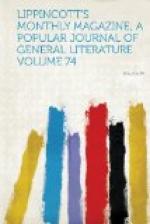The footing was level and easy. Rocks and precipices were left behind, and were displaced by a soft, slippery sort of sand, where from space to space were planted, like so many oases in a desert, clumps of giant reeds. By a strange but natural caprice these beds of rustling verdure were cut in an infinity of well-defined geometric forms. Seen from an eminence and at a distance, this arrangement gave a singular effect. In the midst of these native garden-beds were cut distinct and narrow alleys, where the drifting sands were packed like artificial paths. It is unnecessary to add that the soft footways, notwithstanding their advertisement of verdure and shade, proved to be of African temperature.
The last hours of daylight surprised the travelers among the labyrinths of these strange gardens. A suitable spot was chosen for the halt. As the porters were preparing to throw down their packs, Pepe Garcia, who marched ahead, announced the print of a South American tiger. The first care of the Indians, on hearing this news, was to send forth a horrible cry and to throng around the marks. The footprints disappeared at the thickest part of the jungle. After an examination of the traces, which resembled a large trefoil, they precipitated themselves on the interpreter-in-chief, representing how impossible it was to camp out in the neighborhood of the dreaded animal. But Pepe Garcia, accustomed as he was by profession to try his strength with the ferocious bear and the wily boar, was not the man to be afraid of a tiger, even of a genuine tiger from Bengal. To prove to the porters how slight was the estimation he placed on the supposed enemy, and also to drill them in the case of similar rencounters, he pushed the whole troop pellmell into the thickest part of the reeds, with the surly order to cut down the canes for sheds. Drawing his own knife, he slashed right and left among the stems, which the Indians, trembling with fear, were obliged to make into sheaves on the spot and transport to the beach selected for the bivouac. Double rows of these arundos, driven into the sand, formed the partitions of the cabins, for which their interwoven leaves made an appropriate thatch. The green halls with matted vaults were picturesque enough; each peon, seeing how easily they were constructed, chose to have a house for himself; and the Tiger’s Beach quickly presented the appearance of a camp disposed in a long straight line, of which the timorous Indians occupied the extremity nearest the river.
No “tiger” appeared to justify the apprehensions of the porters; but what was lacking to their fears from beasts with four feet was made up to them by beasts with wings. The night closed in dry and serene. Since leaving Maniri, whether because of the broadening of the valley, the rarity of the water-courses or the decreasing altitude of the hills, the adventurers had been little troubled with fogs at night. The fauna of the region, too, had offered




